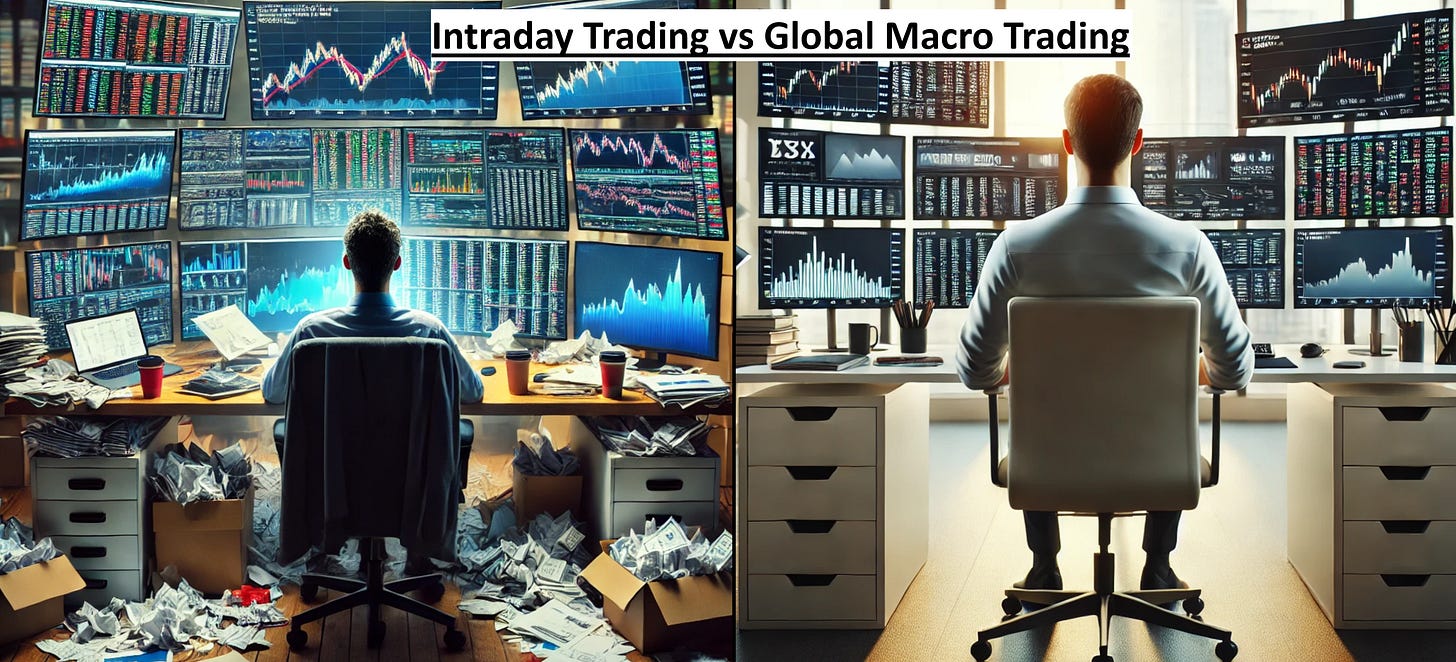What is Global Macro trading:
Global macro trading is an investment strategy that focuses on making large-scale bets on global economic and political events, leveraging insights into macroeconomic trends across countries, regions, and asset classes. Traders look at factors like interest rates, inflation, economic growth, political stability, and central bank policies to predict price movements in currencies, commodities, fixed income, and equities. The purpose is to capitalize on shifts in these fundamental factors, often with a top-down approach (process), to identify assets or markets poised to move based on anticipated macroeconomic changes.
Global macro strategies involve both long and short positions and often use a mix of instruments, including futures, options, swaps, and other derivatives. (Note that we can express most view via futures and options) It typically requires an understanding of how economies interact, as well as a willingness to take on larger, directional bets on specific outcomes (e.g., central bank policy shifts, political developments).
Given its scope and flexibility, global macro trading is a highly adaptable strategy, which allows traders to move capital quickly across different markets based on evolving conditions, making it popular in times of economic uncertainty or significant global transitions.
How is Global Macro better than Intraday Trading?
1. Broader Opportunity to Capture Large Trends
Macro trading focuses on large, global economic shifts, often allowing for the capture of significant, sustained trends over weeks, months, or even years.
Unlike intraday trading, which relies on short-term price fluctuations, macro trading gives traders the chance to benefit from more fundamental economic drivers, potentially yielding higher returns with longer holding periods.
2. Lower Transaction Costs
Intraday trading involves frequent buying and selling, which incurs higher transaction costs due to fees and spreads.
Macro traders tend to make fewer trades, reducing transaction costs and allowing capital to compound over time without the drag of constant fees.
3. Less Impact from Market Noise
Intraday trading can be heavily influenced by minor news releases, price manipulations, and short-term market sentiment, making it highly volatile.
Macro traders focus on larger economic trends, so they’re less affected by these short-term fluctuations, which allows for a clearer view of long-term opportunities.
4. Leverage of Fundamental Knowledge
Macro traders who understand global economic drivers, monetary policies, and geopolitical factors can use this insight to anticipate longer-term trends.
This advantage is often lost in intraday trading, which generally relies on technical analysis or price patterns, with less focus on fundamental data.
5. Greater Flexibility and Diversification
Macro trading strategies can apply to various asset classes, such as currencies, commodities, bonds, and equities, providing opportunities across multiple markets and regions.
Intraday trading, particularly in single markets or instruments, is more limited in scope, often requiring a focus on specific price movements rather than diversified opportunities.
6. Potential for Higher Risk-Reward Asymmetry
With macro trading, traders aim to identify mispricings that offer strong asymmetric risk-reward profiles, meaning the potential upside may significantly outweigh the downside.
Intraday trades, by contrast, are typically smaller in magnitude, often requiring a higher win rate to maintain profitability.
7. Reduced Time Pressure and Stress
Macro trading involves longer holding periods and less frequent decision-making, which can reduce the time-sensitive stress that intraday traders face.
Intraday trading requires constant monitoring of the markets, which can be mentally and emotionally demanding, often leading to burnout.
Conclusion:
Intraday trading subjects you to a multitude of opaque and noisy elements, where distinguishing valuable signals can be challenging. In contrast, global macro trading provides more "room to breathe" by focusing on shifts in observable and testable economic indicators, allowing for strategic, data-driven decisions rather than reaction to fleeting market fluctuations.
Intraday trading also incurs high costs and considerable stress, with any competitive edge easily eroded by advanced algorithms optimized for high-frequency, data-intensive analysis and perfect execution. Macro trading, by contrast, involves fewer costs and is less vulnerable to algorithmic manipulation. However, the real challenge in macro trading lies in achieving "execution alpha"—the skillful execution of the trade itself.
For example, it’s one thing to predict that inflation may fall, expecting the central bank to lower rates, and deciding to buy SOFR contracts. While the call may be correct, success hinges on refining the timing of entry, setting effective stop-loss levels, and precisely calibrating risk allocation relative to potential targets. This nuanced execution separates effective macro trades from simply "good calls."
Welcome to Global Macro Method, in the substack I will seek to teach and showcase my execution while sharing the processes that lead to +EV trading and ultimately making some PnL!


